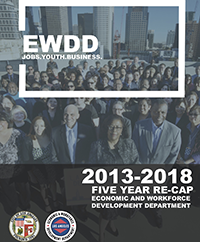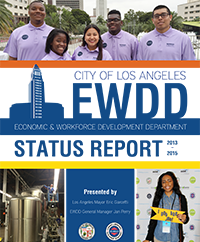
Reports and Annual Plans
- Regional & Local Strategic Workforce Development Plans
- Annual Plans - Workforce Development Board
- AdvantAGE LA
- LA Workforce Infrastructure Network Concept Paper
- Horizons 32K Strategic Plan
- L.A. Performance Partnership Pilot (LAP3)
- Citywide Economic Development Strategy (CEDS)
- EWDD Status Reports
- Economic Development Subsidy Reports
- A Portrait of Los Angeles County
-
Regional & Local Strategic Workforce Development Plans
The Local and Regional Workforce Development Plans outline workforce development strategies and are separated into Local Workforce Development Plans and the Los Angeles Basin Region’s Workforce Development Plan. The plans summarize administration, program budgets, program goals, and service strategies for a stated period. The Local Strategic Workforce Plans align with the State of California Workforce Development Board's Strategic State Plan for California's Workforce Investment system.
- DRAFT Local Workforce Plan, Program Years 2025-2028
open for public review and comment through April 11, 2025
March 2025 - Local Workforce Plan, Program Years 2021-2024
April 2022 - Local Workforce Plan Biennial Modification
April 2023
- Los Angeles Basin Regional Planning Unit
- WIOA Local Workforce Development Plans
- DRAFT Local Workforce Plan, Program Years 2025-2028
-
Annual Plans - Workforce Development Board
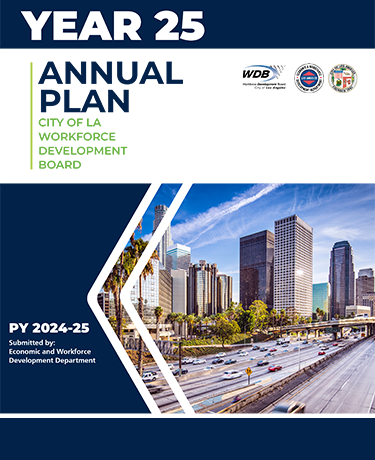 The Annual Plan covers the service strategies, activities, and budget for the City’s Workforce Development System. It outlines how the City will deliver services and meet the objectives of promoting a trained workforce with access to good jobs and a strong business/employer regional economy.
The Annual Plan covers the service strategies, activities, and budget for the City’s Workforce Development System. It outlines how the City will deliver services and meet the objectives of promoting a trained workforce with access to good jobs and a strong business/employer regional economy.
The Workforce Development System is comprised of WorkSource/America's Job Centers of California, YouthSource Centers, and satellite sites, supported by the Workforce Innovation and Opportunity Act (WIOA).
- Year Twenty-Five Annual Plan, Program Year 2024-2025
November 2024 - Year Twenty-Four Annual Plan, Program Year 2023-2024
December 2023 - Year Twenty-Three Annual Plan, Program Year 2022-2023
March 2023 - Year Twenty-Two Annual Plan, Program Year 2021-2022
February 2022 - Year Twenty-One Annual Plan, Program Year 2020-2021
August 2020 - Year Twenty Annual Plan, Program Year 2019-2020
September 2019
- Year Twenty-Five Annual Plan, Program Year 2024-2025
-
AdvantAGE LA

A Blueprint for Employing, Retaining, and Advancing Older Workers Across LAIn an era characterized by rapid change and evolving job markets, the marginalization of Older Workers frequently sidelines individuals who possess invaluable experience and expertise. With a shrinking pool of skilled workers, businesses cannot afford to overlook the wealth of skills older employees offer.
AdvantAGE LA offers actionable recommendations for employers to capitalize on these opportunities, facilitating upskilling, reskilling, and the exploration of new career pathways for employees of all ages. By investing in Older Workers’ continued growth and development, businesses can retain valuable institutional knowledge and expertise while fostering a culture of lifelong learning for employees of all ages.
AdvantAGE LA also provides recommendations for municipalities, service providers, community-based organizations, and education and training providers needed to support Older Workers. By fostering age-inclusive workplaces and investing in the growth and development of employees across all stages of their careers, we can unlock the full potential of our workforce.
Older Adults already represent a significant part of the regional labor force, having outpaced the City’s general population over the past decade. They are working later into retirement, driven by a combination of inflation, uncertainties around economic safety net programs, and an intrinsic desire to remain involved in the workforce. These workers are highly competent and able to meet the demands of modern work.
-
LA Workforce Infrastructure Network Concept Paper
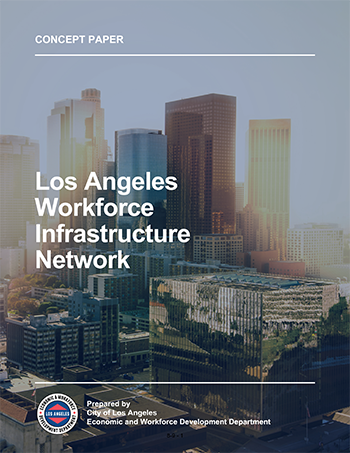
The Economic and Workforce Development Department, the LA City Workforce Development Board and the Mayor’s Office commissioned this concept paper to develop high-level recommendations from crucial partners of the Los Angeles workforce development eco-system to:
Los Angeles and the wider region are poised to receive extraordinary financial support to develop crucial infrastructure, renewable energy projects and expand broadband access. Beyond the anticipated federal funds dedicated to infrastructure, the city has boosted its own spending on housing, transportation, renewable energy, and water management.- Assess the status of workforce preparation for federal Investment Infrastructure and Jobs Act (IIJA) and Inflation Reduction Act (IRA) capital investments;
- Develop strategies to prepare the Los Angeles workforce for these investments and;
- Ensure equity and inclusion in the new quality skilled career pathways opportunities for all LA residents.
This wave of investment from federal, state, and local sources is expected to create thousands of construction and infrastructure-related jobs in the area. While the exact number of jobs is yet to be determined, it is widely acknowledged that we will see a significant increase in high-quality, career advancing positions in skilled trades.
LA Workforce Infrastructure Network Concept Paper
November 2024 -
Horizons 32K Strategic Plan

LA Performance Partnership PilotThe LA P3 - Horizons 32K Strategic Plan is a roadmap to a future where all Los Angeles opportunity youth secure and persist in quality education, training, and employment pathways.
Government and community leaders are embracing our collective responsibility for changing the systemic conditions contributing to youth disconnection in Los Angeles County through the LA P3 strategic plan “Horizons 32K: Los Angeles’s Blueprint for 32,000 Opportunity Youth Dreams”. Building from the successes of the previous LA Performance Partnership Pilot (LAP3) strategic plan, the new Horizons 32K strategic plan reaffirms our commitment to serving LA County’s 143,000 opportunity youth, charting a course toward a more inclusive, supportive future.
Horizons 32K Strategic Plan
November 2024 -
L.A. Performance Partnership Pilot (LAP3)
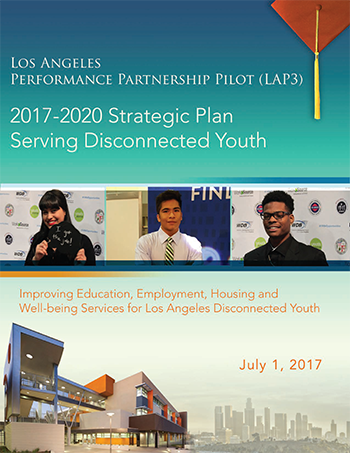 Nearly one out of six young people, ages 18-24, in the City and County of Los Angeles are out of school and out of work. This statistic translates into over 170,000 young people in the county, which 66,400 live in the City of Los Angeles, who will face future economic challenges, unless they are reconnected to educational and employment opportunities. The Los Angeles Performance Partnership Pilot means providing a second chance for those young adults who dropped out of high school; an employment and career start for those not in the workforce; access to housing, health and social resources and services to those in need.
Nearly one out of six young people, ages 18-24, in the City and County of Los Angeles are out of school and out of work. This statistic translates into over 170,000 young people in the county, which 66,400 live in the City of Los Angeles, who will face future economic challenges, unless they are reconnected to educational and employment opportunities. The Los Angeles Performance Partnership Pilot means providing a second chance for those young adults who dropped out of high school; an employment and career start for those not in the workforce; access to housing, health and social resources and services to those in need.
The Performance Partnership Pilot Strategic Plan provides the most current data on the region’s “Opportunity Youth” population. It highlights current efforts to build a better system of care, and most importantly provides recommendations to our elected public bodies and to our philanthropic partners on action steps that would lower the disconnection rate from one out of six to a much lower ratio.
-
Citywide Economic Development Strategy (CEDS)
- September 2019
- Citywide Economic Development Strategy (CEDS)
Volume I - StrategyVolume II - Appendices- Executive Summary
- Strategy Development Overview
- City and Focus Area Sociodemographic and Industry Context
- Economic Development Existing Conditions and Global Best Practices
- Strategy Purpose and Vision
- Long-Term Goals
- Five Year Implementation Plan
- Focus Area Strategies
- Acknowledgments
- City and Focus Area Demographic, Economic and Industry Context
- Economic Development Existing Conditions
- Global Best Practices
- Strengths, Weaknesses, Opportunities and Threats
- Evaluation Framework
- Summary of Phase 1 and Phase II Feedback
- US Economic Development Agency Eligibility Criteria
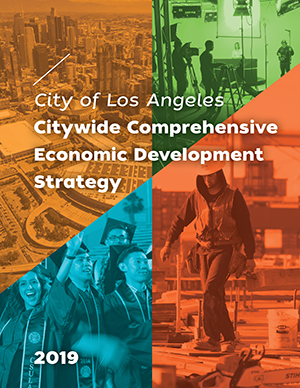
-
EWDD Status Reports
-
Economic Development Subsidy Reports
(California Government Code Section 53083)
2018
2017
2016- Los Angeles Grand Avenue Development
- Thai Community Development Center - consideration report
2015
2014 -
A Portrait of Los Angeles County
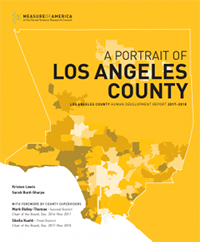 Measure of America, a project of the Social Science Research Council, released a comprehensive report that measures well-being across race, place, and gender in LA County. Using the American Human Development (HD) Index — a standardized metric created by Measure of America that combines health, education, and earnings data — Portrait of LAC examines 106 cities and unincorporated areas in LA County as well as thirty-five community plan areas within the City of Los Angeles.
Measure of America, a project of the Social Science Research Council, released a comprehensive report that measures well-being across race, place, and gender in LA County. Using the American Human Development (HD) Index — a standardized metric created by Measure of America that combines health, education, and earnings data — Portrait of LAC examines 106 cities and unincorporated areas in LA County as well as thirty-five community plan areas within the City of Los Angeles.
The data is further broken down by race and ethnicity and by gender to reveal critical gaps and areas for improvement. The report, developed in collaboration with LA County departments and the Southern California Grantmakers, will help policymakers, businesses, philanthropists, and advocates identify areas of need and tailor interventions accordingly, building the capabilities people need to seize opportunities and live up to their full potential.
For this report, a ranked index has been calculated for 106 cities and unincorporated areas in LA County as well as the thirty-five community plan areas within the City of Los Angeles; for major racial and ethnic groups; for women and men; and for US- and foreign-born LA County residents
2017-2020 Strategic Plan Serving Disconnected Youth
November 2017



